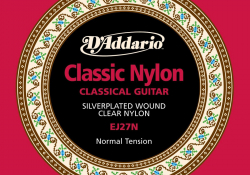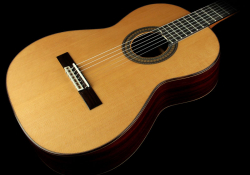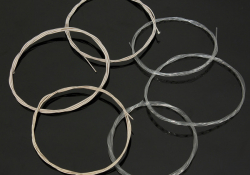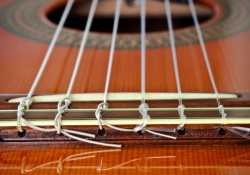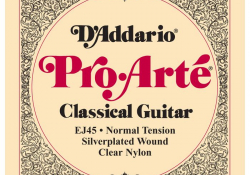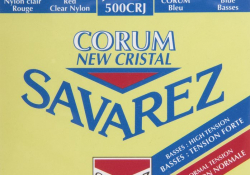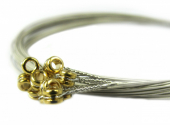
How To Choose Strings for Classical Guitar
Choosing the right guitar strings in today's abundance of choice is not an easy task. Particularly so for less experienced and novice guitarists. It often happens that they put strings on their guitars that are either completely the wrong ones or at least not suitable for their playing and style. I'll try to make this clearer for you. And since strings fall into three basic categories, this article will have three parts. I'll start with the classics, that is, classical guitar strings.
Nylon strings
under this designation you can usually find strings designed for classical guitar, popularly known as "Spanish guitar". These instruments are most often used to play so-called "serious" or classical music, but also in flamenco or popular music. The sound of nylon strings can be found quite freely in rock, pop, and even jazz music.
But whatever style of nylon-string classical guitar you're considering playing, the main thing for us is to advise you on its selection and maintenance. We'll talk a little about their composition and very briefly about their history. In fact, nylon itself is a relatively young material, first appearing only around 1940. Until then, classical guitar strings were made exclusively from natural materials such as silk or animal intestines. You can still find strings made from these materials today, but they are very expensive and are intended for the most expensive master instruments. Although they have the advantage of longer life than nylon strings, they are also much more demanding to maintain and harder to keep in tune.
In terms of their composition, every string, whether metal or nylon, is made up of a core. In the case of nylon strings, of course, the core is nylon and is of a circular cross-section. Melodic strings (without windings) are made up of only this core, bass strings (wound) are made up of a nylon core and a sheath of various types of thin metal wire.
Silver or silver-plated copper metal alloy is most commonly used. Both of these metals not only have excellent sound properties, but also mechanical properties such as softness and malleability. The disadvantage of silver-plated copper is that it wears out quite quickly (compared to silver, for example), which makes nylon strings relatively short-lived. On the other hand, unwound strings gain better sonic qualities over time, due to the fact that the nylon strengthens under tension and the strings then have a brighter, louder tone and hold their tuning better. For this reason, some guitarists change only the bass strings more often and leave the melody strings on the guitar significantly longer. Here, however, the emphasis should be on using the same sets, the same brand and the same strength.
Choosing a type of strings
Although there is indeed a large variety of nylon strings on the market, I recommend following a few basic tips when choosing one. First of all, it is better (especially if you own a higher quality instrument) to choose from established brands (e.g. D'Addario, La Bella, Aquila or Savarez) and possibly more expensive sets. The more expensive sets have silver windings and a core made of several nylon fibers, which gives them a longer life and even better sound characteristics.
As far as string strength is concerned, the situation is a bit simpler than with metal strings, as they are basically divided into only two groups, namely Normal Tension and Hard Tension. Within these two categories, they are further divided into soft, medium, hard and extra hard. So here it depends on what one prefers and how one intends to play the classical guitar. It is understandable that a rock guitarist, who wants to use nylon strings just to make his playing more varied, and who will, heaven forbid, use a pick (classical guitarists are certainly getting the shivers right now:-)), will choose thicker strings. But everything here is based more on personal feelings, experience and the need to search and experiment. The result will eventually always come.
Changing the strings
A specific feature of nylon strings is also their attachment to the guitar headstock and the bridge. Unlike metal strings, they are tied. There are many detailed instructions on what such binding should look like and there is no point in going into it here, especially when there are several possibilities of binding. Better to watch an instructional video. And those who still don't have enough courage to tie the strings can take advantage of the kindness of some manufacturers, who now offer nylon strings for classical guitars with a ball end, so you can just push them through the fretboard like regular metal strings. However, I would like to point out here that I do not recommend using metal strings on classical guitars! The guitar is not built for the tension of these strings, which is several times higher than the tension of nylon strings, and such an experiment usually results in the bridge coming loose or warping the neck, and you can wave your guitar goodbye.
Maintenance of strings
Finally, a few words on the maintenance of nylon strings. Here, more than other types of strings, it should be true that we should make sure that our hands are washed and thoroughly dried before playing, as dirt, grease and sweat are the greatest enemies of strings and nylon strings in particular. After playing it is also important to clean the strings themselves. We can either use one of the commercially available string cleaners (again, I recommend the established brands, e.g. Dunlop, Ernie Ball, GHS, etc.), but a clean, dry cloth used to clean the strings along their entire length will also suffice. Of course, everything in moderation... clean thoroughly, but carefully, as with wound strings you can easily tear the winding and destroy the string.
So good luck with your string selection and maintenance and may your strings play long and well...
Was this article helpful to you? Let us know in the comments below.
If you have found an error or typo in the article, please let us know by e-mail info@insounder.org.

